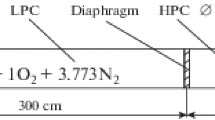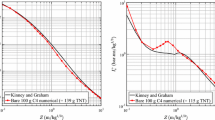Abstract
Mathematical modeling is used to study the ignition of magnesium particles near the end of a shock tube by the action of the transmitted and reflected shock waves. A comparison with experimental data showed that the particle motion and the dependence of the system thermophysical parameters on the system state must be considered in determining the ignition delay time as a function of the temperature behind the shock front.
Similar content being viewed by others
Literature Cited
J. M. Fox, J. A. Tevelde, and J. A. Nicholls, “Shock wave ignition of metal powders,” Proc. 1976 Heat Transfer and Fluid Mechanics Institute, Davis and Stanford, CA (1976), pp. 241–256.
A. E. Medvedev, A. V. Fedorov, and V. M. Fomin, “Mathematical modeling of the ignition of metal particles in the high-temperature flow behind a shock wave,” Fiz. Goreniya Vzryva,18, No. 3, 5–9 (1982).
V. M. Boiko, A. V. Fedorov, V. M. Fomin, et al., “Ignition of small particles behind shock waves,” Shock Waves, Explosions, and Detonations, ed. by J. R. Bowen, N. Manson, A. K. Oppenheim, and R. I. Soloukhin, Prog. Astron. Aeron.,87, 71–87 (1983).
E. A. Afanas'eva and V. A. Levin “Ignition of aluminum particles behind detonation and explosive waves,” Khim. Fiz., 3, No. 9, 1328–1332 (1984).
A. V. Fedorov, E. V. Tetenov, and B. Vess'er, “Dynamics and ignition of metal particles dispersed in the atmosphere for a real explosion,” Preprint No. 6-90 [in Russian], Academy of Sciences USSR, Siberian Branch, Institute of Theoretical and Applied Mechanics, Novosibirsk (1990).
V. M. Boiko and A. N. Papyrin “Ignition of magnesium particles behind reflected shock waves,” Material of the 8th All-Union Symposium on Combustion and Explosion, Chernogolovka, October 13–17, 1986 [in Russian], Chernogolovka (1986), pp. 65–68.
N. N. Semenov, “Thermal theory of combustion and explosion,” Usp. Fiz. Nauk,23, No. 3, 251 (1940).
M. A. Gurevich and A. M. Stepanov, “Ignition of metallic particles,” Fiz. Goreniya Vzryva,4, No. 3., 334–342 (1968).
Additional information
Novosibirsk. Translated from Fizika Goreniya i Vzryva, Vol. 27, No. 6, pp. 139–142, November–December, 1991
Rights and permissions
About this article
Cite this article
Petukhova, E.V., Fedorov, A.V. Ignition of magnesium particles near the end of a shock tube. Combust Explos Shock Waves 27, 778–780 (1991). https://doi.org/10.1007/BF00814528
Received:
Issue Date:
DOI: https://doi.org/10.1007/BF00814528




